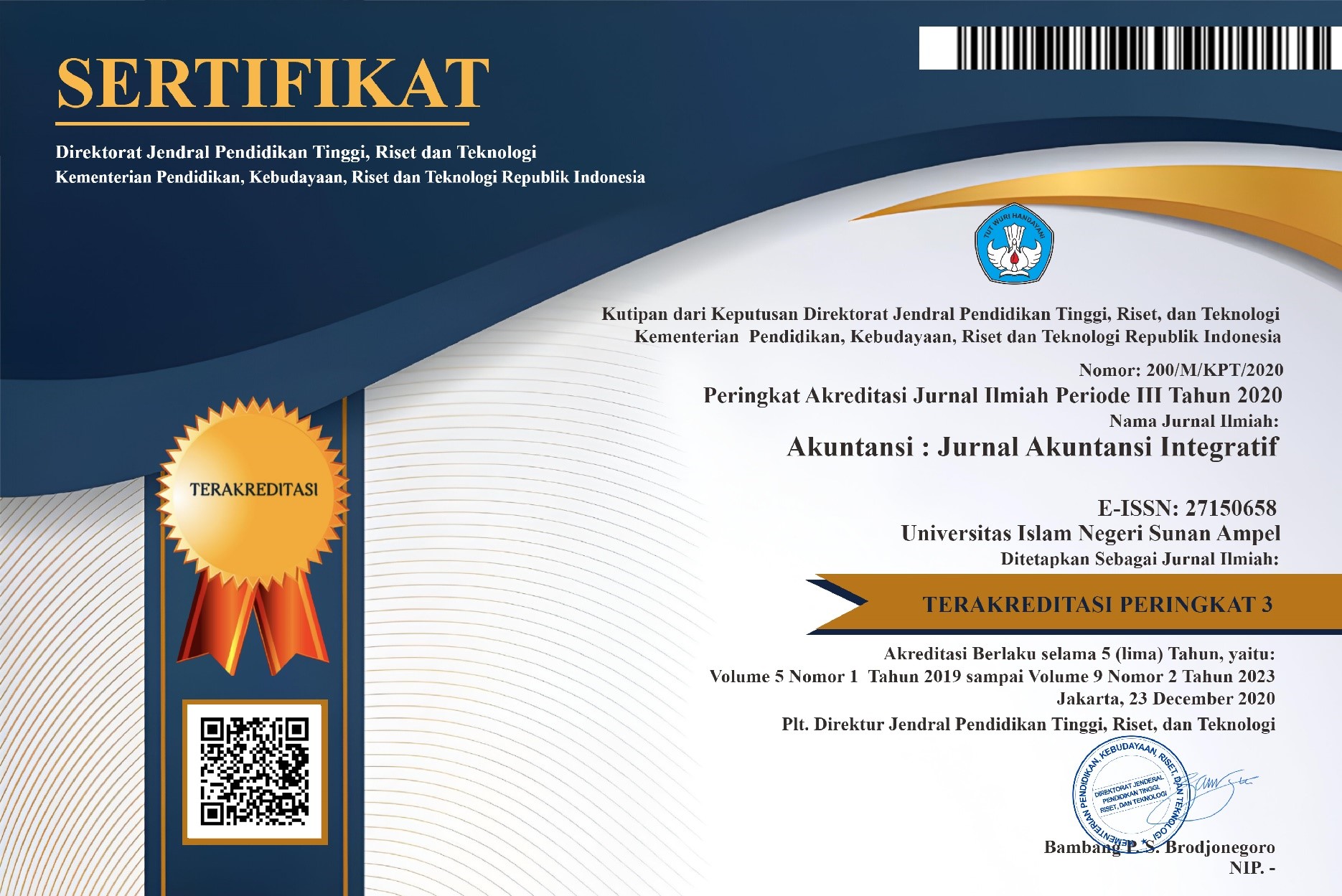Peningkatan Literasi Digital Era New Normal: Studi Kasus Pembelajaran Daring Mahasiswa Akuntansi UPN Veteran Jawa Timur
DOI:
https://doi.org/10.29080/jai.v7i1.457Keywords:
Digital literacy, E-learning, New normal, Online Learning, Online TutorialAbstract
Abstract
The rapid development of ICT and the digital world has changed many things. Education in the new normal era must innovate to integrate ICT. This study aims to determine the digital literacy competence of Accounting students FEB UPN Veteran East Java; and Formulating strategies to improve digital literacy competencies for Accounting students of FEB UPN Veterans East Java. In addition to digital infrastructure, it is necessary to design learning models such as curriculum that is integrated with digital literacy (Stein and Graham, 2014). European Commission Digital Competency Framework 2.1 (Carretero, Vuorikari & Punie, 2018), covers five aspects, namely information/data literacy; communication/collaboration; digital content creation; security; and problem solving. This research method uses mixed methods (survey/interview). Quantitative and qualitative data analysis. The results showed that from the five aspects of digital literacy competence, Accounting students of FEB UPN Veteran Jatim were categorized both in the aspects of Information/data literacy and Communication/collaboration. Next is the aspect of creating digital content; Security; and Troubleshooting, need improvement. Strategies to improve digital literacy competence are to direct students to: think critically; using digital media; manage online identity; managing digital distractions; digital experience practice; and get out of your comfort zone.
Downloads
References
Stenger, Marianne. (2018) .7 Ways to Teach Digital Literacy. pada https://www.opencolleges.edu.au/informed/edtech-integration/7-ways-teach-digital-literacy/. akses 24 April 2021
Bates, A.W. (2015). Teaching in a Digital Age, Eb- ook, Tony Bates Associates Ltd. ISBN 978- 0-9952692-0-0.
Mery, Y., & Newby, J. (2014). Online by design. Lanham, MA: Rowman & Littlefield Pub- lishers.
Kerr, Marcel & Rynearson, Kimberly & Kerr, Marcus. (2006). Student characteristics for online learning success. The Internet and Higher Education. 9. 91-105. 10.1016/j.ihe- duc.2006.03.002.
Maria Spante, Sylvana Sofkova Hashemi, Mona Lundin & Anne Algers. (2018) Digital competence and digital literacy in higher education research: Systematic review of concept use, Cogent Education, 5:1, 1519143, DOI: 10.1080/2331186X.2018.1519143
Bawden, D. (2008). Origins and concepts of digital literacy. In C. Lankshear & M. Knobel (Eds.), Digital literacies: Concepts, policies and practices (pp. 17-32). New York: Peter Lang. Retrieved from http://pages.ucsd.edu/~bgoldfarb/comt109w10/reading/Lankshear-Knobel_et_al-DigitalLiteracies.pdf
Gilster, P. (1997). Digital literacy. New York: Wiley Computer Pub.
Lankshear, C., & Knobel, M. (2008). Digital literacies: Concepts, policies and practices. New York: Peter Lang.
Littlejohn, A., Beetham, H., & McGill, L. (2012). Learning at the digital frontier: A review of digital literacies in theory and practice. Journal of Computer Assisted Learning, 28, 547–556. 2729.2011.00474.x
Ala-Mutka, K. (2011). Mapping digital competence: Towards a conceptual understanding. JRC Technical Notes, JRC67075. Seville: Institute for Prospective Technological Studies. Retrieved from http://ftp.jrc.es/EURdoc/JRC67075_TN.pdf
Martin, A., & Grudziecki, J. (2006). DigEuLit: Concepts and tools for digital literacy development. Innovation in Teaching and Learning in Information and Computer Sciences, 5(4), 249–267. https://doi.org/10.11120/ital.2006.05040249.
Carretero, S., Vuorikari, R., & Punie, Y. (2018). DigComp 2.1: The digital competence framework for citizens with eight proficiency levels and examples of use. Luxembourg: Publications Office of the European Union. https://doi.org/10.2760/38842
Spires, H., & Bartlett, M. (2012). Digital literacies and learning: Designing a path forward. Friday Institute White Paper Series. Retrieved from https://www.fi.ncsu.edu/wp-content/uploads/2013/05/digital-literacies-and- learning.pdf
Borthwick, A., & Hansen, R. (2017). Digital literacy in teacher education. Are teacher educators compe- tent? Journal of Digital Learning in Teacher Education, 33(2), 46–48.
Helsper, E. (2008). Digital inclusion: An analysis of social disadvantage and the information society. London: Department for Communities and Local Government.
Tsai, M. (2002). Do male and female students often perform better than female students when learning computers? A study of Taiwanese eight graders’ computer education through strategic and cooperative learning. Journal of Educational and Computing Research, 26(1), 67–85.
Zurkowski, P. (1974). The information service environment relationships and priorities. Related paper no. 5. Washington, DC: National Commission on Libraries and Information Science.
Harrison, C. (2017). Critical internet literacy: What is it, and how should we teach it? Journal of Adolescent & Adult Literacy, 61(4), 461–464.
Christ, W., & Potter, W. (1998). Media literacy, media education, and the academy. Journal of Communica- tion, 48(1), 5–15.
Heydon, R. (2007). Making meaning together: Multi-modal literacy learning opportunities in an intergenerational art programme. Journal of Curriculum Studies, 39(1), 35–62.
Gruszczynska, A., & Pountney, R. (2013). Developing the concept of digital literacy in the context of schools and teacher education. Enhancing Learning in the Social Sciences, 5(1), 25–36.
Gruszczynska, A., Merchant, G., & Pountney, R. (2013). Digital futures in teacher education: Exploring open approaches towards digital literacy. The Electronic Journal of e-Learning, 11(3), 193–206.
Oliver, R., & Herrington, J. (2001). Teaching and learning online: A beginner's guide to e-learning and e-teaching in higher education. Perth: Edith Cowan University, Centre for Research in Information Technology and Communica- tions.
Biggs, J., & Tang. C. (2007). Teaching for quality learning at university (3rd ed.). Berkshire: Society for Research into Higher Education & Open University Press.
Stein, J., & Graham, C. R. (2014). Essentials for blended learning: A standards-based guide. New York, NY: Routledge. https://doi.org/10.4324/9780203075258
Downloads
Published
How to Cite
Issue
Section
License
Copyright (c) 2021 Endang Sholihatin, Nanang Haryono, Invony Dwi Aprilisanda, Astrini aning widoretno, Ika Korika Swasti, Erwin Kusumastuti, Roziana Febrianita

This work is licensed under a Creative Commons Attribution-ShareAlike 4.0 International License.









